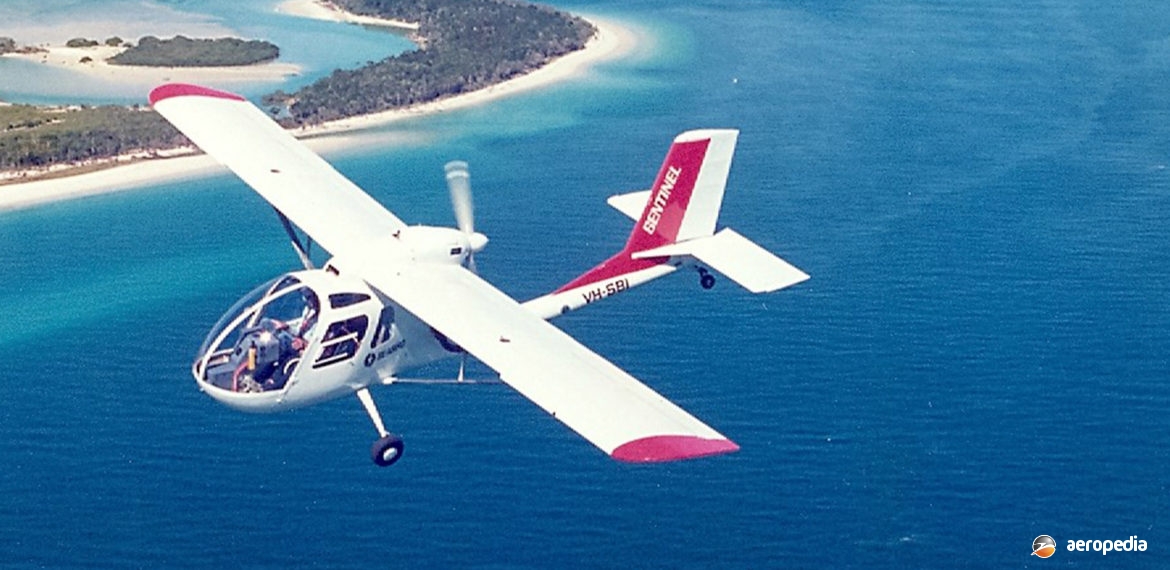Photograph:
Prototype Seabird SB-4 Sentinel VH-SBI (c/n 89001) in the Hervey Bay, QLD area (Seabird Aviation)
Country of origin:
Australia
Description:
Two-seat observation and training aircraft
Power Plant:
One 67 kw (90 hp) Norton Aerotor NR 642-GE-90 twin rotor rotary engine
Specifications:
- Wingspan: 10.60 m (34 ft 9¼ in)
- Length: 6.70 m (21 ft 11¾ in)
- Height: 1.83 m (6 ft 0 in)
- Wing area: 12.77 m² (137.46 sq ft)
- Never exceed speed: 235 km/h (146 mph)
- Max speed at 1,525 m (5,000 ft): 193 km/h (120 mph)
- Max cruising speed at 1,525 m (5,000 ft): 166 km/h (103 mph)
- Cruising speed at 70% power: 157 km/h (98 mph)
- Stalling speed flaps down: 71 km/h (44 mph)
- Max rate of climb at sea level: 244 m/min (600 ft/min)
- Service ceiling: 4,875 m (16,000 ft)
- Take-off run: 92 m (300 ft)
- Landing run: 92 m (300 ft)
- Take-off to 15 m (50 ft): 305 m (1,000 ft)
- Landing run from 15 m (50 ft): 365 m (1,200 ft)
- Range with 45 mins reserve, standard fuel and max payload: 704 km (437 miles)
- Range with max optional fuel: 1,480 km (920 miles)
- G limits: +4.4 / -2.23 in utility category
- Standard fuel capacity: 114 litres (25 Imp gals)
- Optional fuel capacity: 200 litres (44 Imp gals)
- Empty weight (prototype): 405 kg (893 lb)
- Max take-off weight in utility role: 650 kg (1,433 lb)
- Max loaded weight: 750 kg (1,653 lb)
History:
The SB-4 Sentinel was Seabird Aviation Australia’s first foray into the fully certified field, having previously been involved in the ultralight field, producing the SB-1 Rouseabout, and a two-seat derivative known as the SB-1 Bushranger. The Sentinel was designed and built to FAA FAR.23 light aircraft standard. Design work began in January 1985 and construction of the prototype began in January 1988. The prototype, VH-SBI (c/n 89001), fitted with a Norton Aerotor NR 642 rotary engine, made its first flight (36 minutes) on 1 October 1989 at Hervey Bay. It was withdrawn from service in August 2004. Three prototypes were built, a second (c/n 002) being a structural test airframe, and a further example (c/n 003) fitted with an Emdair CF-112 geared engine with fuel injection.
The series was aimed at the surveillance, training, or observation markets, and combined helicopter visibility with short field and slow-flying performance. It was to be made available for civil or military markets. Construction was basically all-metal using 6061-T6 aluminium alloy and 4130 steel tube with some Kevlar used on the forward fuselage skin. It was also aimed at the training or agricultural role. It was of pod and boom structure with a sweptback fin and horn balanced rudder. The undercarriage was of the non-retractable type with Cleveland mainwheels on cantilever spring steel legs with a Maule tailwheel. In due course the SB-4 became the SB-5, later the SB-5E.
The Norton rotary engine was initially installed in the prototype but problems encountered with this unit turned the design team to the Emdair CF-112 two-cylinder engine, also providing 67 kw (90 hp). Later, after some testing, it was decided to install the Lycoming O-360 series engine and this model became known as the Seeker. The second prototype (c/n 002) was a static test frame. The Sentinel was initially to be produced in two variants, the SB-5E with the Westlake-built Emdair (1850 cc) unit and the SB-5N with the Norton rotary. It was fitted with a two-blade MT fixed-pitch propeller but a three-blade electric controllable propeller was optional. Drive was through a 1.5:1 reduction gearbox.
The third prototype VH-SBU (c/n 90-003) made its first flight in 1990 and after completion of development testing was withdrawn from service in August 2004. Standard fuel capacity initially was 115 litres (25 Imp gals) but optional tanks lifted this to 192 litres (42 Imp gals); and a three-blade electric controllable propeller was to be optional. The second prototype was fitted with a hush-kit developed by Seabird to permit the aircraft to be used in the surveillance role with very low noise level. Production took place at the Company’s facility at Hervey Bay, QLD.
Two flying prototypes and two pre-production aircraft were initially planned before full production was to proceed. The two models became known as the SB-5E (E for Emdair) and SB-5N (N for Norton). Design work was carried out by William Whitney of CW Whitney Pty Ltd and Donald Adams founder of Seabird Aviation. By 1990 more than 70 expressions of interest in the design had been received. The fourth aircraft built (c/n 004) became VH-ZIG and was considered to be a prototype for the Seeker series, the two pre-production aircraft becoming the fifth and sixth aircraft completed.
Other aviation related personnel involved in the final stages of the FAR.23 process included John Corby of Corby Aeronautics; Daffyd Llewllyn, the flight test engineer supporting the chief test pilot, David P Eyre, a former chief flying instructor in Port Moresby and at the Royal Queensland Aero Club who worked with Rex Aviation for a time, who had more than 14,000 flying hours; and Robert Blakely formerly of the CAA who advised on workshop procedures etc. During development the Company received both Federal and State Government research grants. Initial production capacity was expected to be 25 aircraft per year.
Eventually, following certification, it was found customers required a larger aircraft, with increased gross weight and with more power able to seat four, and this became the SB-7 Seeker series which is dealt with separately.

